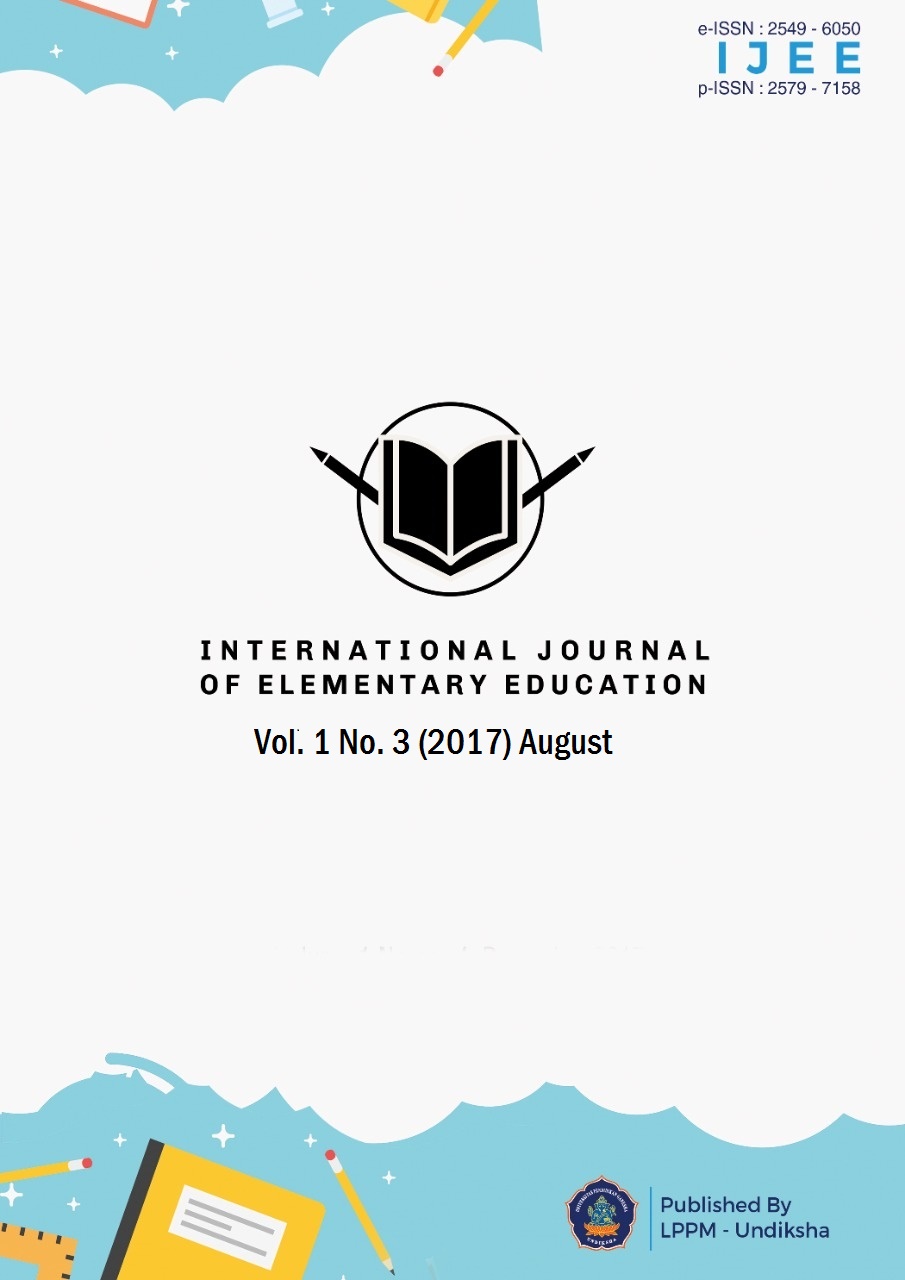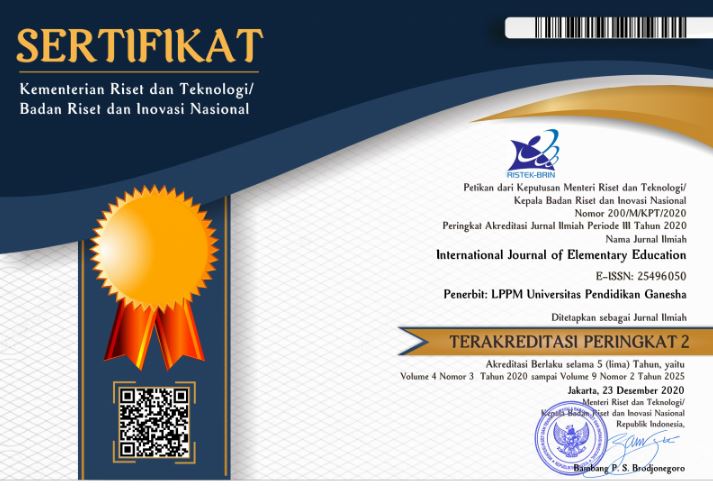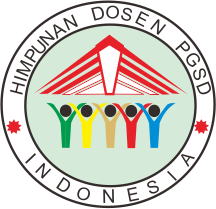PENGARUH MODEL POLYA TERHADAP KEMAMPUAN PEMECAHAN MASALAH MATEMATIKA SISWA KELAS V SD
DOI:
https://doi.org/10.23887/ijee.v1i3.11887Abstract
This study aimed at investigating different performances in solving mathematical problems of fifth grade students who attends learning process in polya model and students who attends learning process which not used polya model in Cluster I Airlangga Mendoyo Sub-district in academic year 2016/2017. This study was a quasi-experimental research that is post-test only control group design. The population of this study was all of fifth grade students of elementary school in Cluster I Airlangga Mendoyo Sub-district. The population of the study consisted of eleven classes with 183 students. Random sampling technique was used to determine the sample of the study. The data collection was conducted through test. The instrument of the data collection was essay test. The data collected through test was analyzed descriptively to find out the mean, median, mode and inferentially by conducting t-test (polled variance). The result of hypothesis testing shows that there is significant difference of students’ ability in solving mathematical problem between students who attend learning process in polya model and students who attend a learning process which not use polya model. The finding indicates that learning process in polya model make students to actively participate in discussion to solve mathematical problem presented. Furthermore, the phases of polya model train students to work systematically in solving the problem. Thus, polya model give significant effect on fifth grade students’ ability in solving mathematical problem in Cluster I Airlangga Mendoyo Sub-district in academic year 2016/2017.
References
Agung, A. A. Gede. 2014. Metodologi Penelitian Pendidikan. Edisi 2. Malang: Aditya Media Publishing.
Aisyah, Nyimas, dkk. 2007. Pengembangan Pembelajaran Matematika SD. Direktorat Jenderal Pendidikan Tinggi Departemen Pendidikan Nasional.
Barb, Cynthia dan Anne Larson Quinn. 1997. “Problem Solving Does Not Have To Be A Problem”. National Council of Teacher of Mathematics. Vol. 90, Issue: 7 (hlm. 536-542). Tersedia pada http://search.proquest.com/docview/201686584?accountid=38628. Diakses tanggal 12 Januari 2017.
Astriningsih, Ni Ketut. 2015. “Penerapan Model Polya Berbantuan Soal Cerita untuk Meningkatkan Hasil Belajar Matematika Siswa Kelas V Semester I”. e-Journal MIMBAR PGSD Universitas Pendidikan Ganesha. Vol. 3, No. 1. Tersedia pada http://ejournal.undiksha.ac.id/index.php/JJPGSD/article/download/6244/4368. Diakses tanggal 31 Januari 2017.
Billstein, Rick, dkk. 2007. A Problem Solving Approach to Mathematics for Elementary School Teacher. Ninth edition. United States of America: Pearson Education.
Dantes, Nyoman. 2012. Metode Penelitian. Yogyakarta: Andi Offset.
Dewi, Sari Kusuma. 2014. “Penerapan Model Polya untuk Meningkatkan Hasil Belajar dalam Memecahkan Soal Cerita Matematika Siswa Kelas V”. Jurnal Mimbar PGSD Universitas Pendidikan Ganesha. Vol. 2, No. 1. Tersedia pada http://ejournal.undiksha.ac.id/index.php/JJPGSD/article/viewFile/2057/1794. Diakses tanggal 31 Januari 2017.
Hensberry, Karina K.R. dan Tim Jacobbe. 2012. “The Effect of Polya’s Heuristic and Diary Writing on Children’s Problem Solving”. Mathematics Education Research Journal. Tersedia pada http://media.proquest.com/media/pq/classic/doc/4147824071/. Diakses tanggal 26 Januari 2017.
Japa, I Gusti Ngurah dan I Made Suarjana. 2014. Pendidikan Matematika I. Singaraja: Universitas Pendidikan Ganesha.
Marlina, Leni. 2013. “Penerapan Langkah Polya dalam Menyelesaikan Soal Cerita Keliling dan Luas Persegi Panjang”. Jurnal Elektronik Pendidikan Matematika Tadulako. Vol. 01, No. 01 (hlm. 43-52). Tersedia pada http://jurnal.untad.ac.id/jurnal/index.php/jepmt/article/download/1708/1125. Diakses tanggal 23 Januari 2017.
Musser, Gary L., dkk. 2008. Mathematics for Elementary Teacher: A Contemporary Approach. United States of America: John Wiley & Sons.
NCTM. 2000. Principles and Standards for School Mathematics. United States of America: NCTM.
O’Daffer, Phares, dkk. 2008. Mathematics for Elementary School Teacher. Fourth Edition. United States of America: Pearson Education.
OECD. 2016. Low Performing Students: Why They Fall Behind and How to Help Them Succeed. Paris: OECD Publishing. Tersedia pada http://dx.doi.org/10.1787/9789264250246-en. Diakses tanggal 31 Januari 2017.
Prihandoko, Antonius Cahya. 2005. Memahami Konsep Matematika secara Benar dan Menyajikannya dengan Menarik. Direktorat Jenderal Pendidikan Tinggi.
Ruminiati. 2008. Pengembangan Pendidikan Kewarganegaraan SD. Direktorat Jenderal Pendidikan Tinggi Departemen Pendidikan Nasional.
Sugiyono. 2010. Statistika untuk Penelitian. Bandung: Alfabeta.
Downloads
Published
How to Cite
Issue
Section
License
Authors who publish with the International Journal of Elementary Education agree to the following terms:
- Authors retain copyright and grant the journal the right of first publication with the work simultaneously licensed under a Creative Commons Attribution License (CC BY-SA 4.0) that allows others to share the work with an acknowledgment of the work's authorship and initial publication in this journal.
- Authors are able to enter into separate, additional contractual arrangements for the non-exclusive distribution of the journal's published version of the work (e.g., post it to an institutional repository or publish it in a book), with an acknowledgment of its initial publication in this journal.
- Authors are permitted and encouraged to post their work online (e.g., in institutional repositories or on their website) prior to and during the submission process, as it can lead to productive exchanges, as well as earlier and greater citation of published work. (See The Effect of Open Access)









